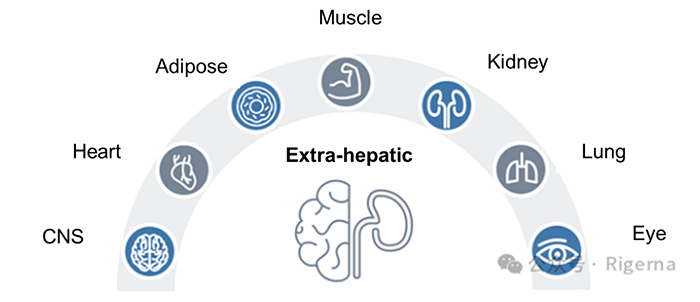Rigerna has Achieved Milestones in Extra-hepatic siRNA Delivery
Release time:May 1st, 2024
Liver-targeting siRNA has been validated and multiple drugs are under development. Extra-hepatic tissues delivery is an inevitable trend with huge potentials. How to invent efficient, safe, and clinically applicable delivery technologies is the key hurdle. Some companies have developed central nervous system (CNS) and lungs targeting delivery platforms and a few pipelines entered clinical trials. However, other tissue-specific targeting delivery remains a huge challenge.

Rigerna is taking the initiative to find unique tissue-specific delivery platforms, including CNS, heart, adipose, muscle, kidney, lung and eye. Among them, LICOD-K1 conjugated siRNA targets kidney specifically and it has been validated in both rodent and non-human primates, with more than 10x difference compared with free-siRNA. This was the first report of Proof-of-Concept in non-human primate worldwide. The knock down efficiency is up to 70% with desirable duration. LICOD-K1 is unlocking the value of innovative therapy aiming at various kidney diseases.

Kidney is one of the most challenging organs for the extracellular delivery of siRNA [1]. As the most complex tissue in the human, kidney is composed of 20+ different cell types with accumulated one million nephrons. Usually, to achieve effective inhibition of target genes in the kidney, the exposure needs to be two orders of magnitude higher than that of tissues such as muscle and the central nervous system [2]. These factors have led to unprecedented challenges in the development of siRNA kidney-targeting delivery technologies.
Rigerna is committed and dedicated to bringing this kidney-targeting siRNA delivery technology into clinical trials, ultimately benefiting tens of millions of kidney patients worldwide.
References:
[1] Ahn I, Kang C S, Han J*. Where should siRNAs go: applicable organs for siRNA drugs. Exp Mol Med, 2023, 55(7): 1283-1292.
[2] Tang Q, Khvorova A*. RNAi-based drug design: considerations and future directions. Nat Rev Drug Discov, 2024, 23(5): 341-364.